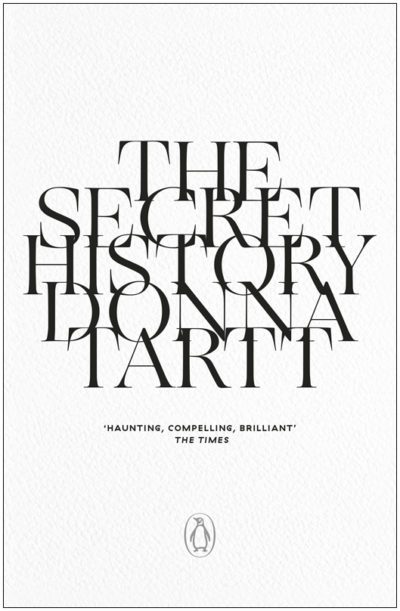It’s a very Greek idea, and a very profound one. Beauty is terror. Whatever we call beautiful, we quiver before it. And what could be more terrifying and beautiful, to souls like the Greeks or our own, than to lose control completely? [1]
Donna Tartt’s writing has been growing in popularity since her Pulitzer Prize for Fiction win for the 2013 novel The Goldfinch. Yet it is her first novel, The Secret History, that has gained a cult following over the years. The novel was published in 1992 and was written partly by Tartt while she was attending Bennington College in Vermont. While the novel was well-received upon publication and Tartt was lauded as a literary genius, she hasn’t received the same notoriety that some of her other Bennington College contemporaries, such as American Psycho author Bret Easton Ellis, have over the years. The Secret History is regarded as a key literary source in the furthering of the dark academia subgenre, and while this is true, Tartt owes a great deal to the gothic horror subgenre with her ability to create skin-crawling terror and tension within her debut novel.
It would be apt to call the Greek classics their own type of horror. After all, the Greeks trafficked in some truly terrifying storytelling. Oedipus gouges his eyes out after learning he had killed his father and married his mother in Oedipus Rex, Clytemnestra brutally slays Agamemnon and Cassandra in the Oresteia, and the followers of Dionysus wreak bloody havoc on a city in The Bacchae. Greek literature is thoroughly steeped in visceral gore that would make most modern consumers of media squirm, but for the ancient Greeks, it was among the highest forms of media, and they reveled in the catharsis that it brought. Tartt leans into this kind of visceral brand of horror in The Secret History and creates a story that celebrates the Greek tradition of tragedy while weaving its own unique gothic thread.
The Secret History is a whydunit instead of a whodunit. From the outset, the reader knows that the classics students at Hampden College have murdered one of their own, Edmund “Bunny” Corcoran. The story is told from the perspective of Richard Papen, who transfers to Hampden and longs to join the ranks of the elusive classics students at the university. The classics students are taught by the mysterious and charming Julian Morrow and include the astute genius Henry Winter, the flamboyant Francis Abernathy, the twins Charles and Camilla Macaulay, and of course, the annoying and crass future murder victim, Bunny Corcoran. Richard does manage to become a member of the classics class, which is sequestered away from the rest of the university where Julian runs the class with a sort of cult-like exclusivity.
At first, Richard is taken with his classmates and becomes enamored with them and their inner world. However, Richard finds himself pulled into the dark secrets that the coterie harbors and learns that in a successful attempt to re-create a bacchanalia, a ritual done under the influence of drugs or alcohol with the intent of honoring the Greek god Dionysus, Henry, Francis, Charles, and Camilla tore a farmer apart with their bare hands. Bunny learns of this murder and is continually blackmailing Henry, and as a means to put the blackmailing to an end, Richard is pulled into a murder plot that continually spirals out of control, even after Bunny is dead and buried.

The secrets and intrigue of The Secret History give way to its haunting nature, and much like all good gothic horror, setting plays a crucial part in how the drama of the story unfolds. The setting is crucial to the plot and serves as a backdrop for the horrific plot points that come to pass. Hampden College is idyllic and engrossing. It seems like any private liberal arts college. It has its own culture and array of vibrant characters. The classics students are like a secret society in the confines of Hampden. The close-knit New England community is the perfect setting for a tale of beauty, terror, and murder. New England has deep and historic ties to gothic literature and horror at large. Tartt mines on those same characteristics to create an atmosphere that keeps readers on their toes, never knowing who to trust or where the plot will go. Richard is originally from California, so he finds himself largely out of his element in a place that is extremely foreign to him. The sense of geographic displacement also mirrors Richard’s desperation in creating a niche for himself at Hampden. Ironically, Hampden is based on Tartt’s alma mater, Bennington College, which was the college where Stanley Edgar Hyman, the husband of the infamous gothic writer Shirley Jackson, taught. Jackson is also cited as being a major influence on Tartt’s writing. Horror has a penchant for putting characters in unfamiliar settings as a way to build dread and tension. Tartt does so in a way that echoes Jackson’s own use of displacement in her works.
The Secret History dabbles in moments of high emotion, a staple of gothic horror. Most of the characters in The Secret History are thrown into emotional extremes, and as the drama of the story picks up, so does the cool and carefully crafted veneer of perfection. Gothic often peels off layers of characters, so to speak, flaying them and revealing an emotional core. Through these high running emotions, a sense of fear is instilled within the characters.
Before the end of the story, Richard has come to fear Henry, a man that he once deeply admired and even revered. Henry’s lack of emotion in situations that would cause even the most stalwart people to crumble is intriguing and horrific. It creates an interesting dichotomy due to the level of emotional distress the story portrays. Henry is revealed to be a sociopath over the course of the novel—and a cunning one at that. Most of the characters in the story are expendable to Henry with the marked exception of Camilla, one of the few people he is genuinely fond of. Henry’s unpredictability adds to the air of danger, and none of the characters can be sure what he will do next. Up until Henry’s last act, he has played a tightly wound game of chess and means to keep control of the situation no matter the cost. He’s the chess master, and he plays the game well.

Henry is a work of terror in himself. He discusses murder quite casually and has no problem recounting the gory details of the bacchanalia. When he recounts the bacchanalia, he does so with ease and discusses the bloody revelry and his lack of feeling for murdering someone. When Richard confronts him about the murder, Henry merely leans back in his chair and laughs. He goes into detail about the gore from the farmer’s murder and says, “He was dead. He was about forty years old and he had on a yellow plaid shirt—you know those woolen shirts that they wear—and his neck was broken, and, unpleasant to say, his brains were all over his face. Really, I do not know how that happened. There was a dreadful mess. I was drenched in blood and there was even blood on my glasses.” [2] It is Henry who devises Bunny’s murder after he is the first to broach the subject of possibly killing Bunny. To Henry, Bunny’s murder is a necessity and no more than a chore that needs to be dispatched. Charles asks Henry how he can possibly justify this particular purposeful murder, to which Henry replies, “I prefer to think of it as a redistribution of matter.” [3] Life means frighteningly little to Henry, setting him apart from the rest of the friend group.
However, Tartt causes the reader to empathize with Henry. His character is shrouded with mystery, but what the reader does learn about him is heartbreaking. He was a victim of a tragic accident as a child that left him with a hideous scar on his forehead and possible brain damage as well. He’s ridiculously intelligent, but his relationship with his father seems to be strained. Henry, while cold and calculating, does show tenderness toward Camilla. It’s a tactic that is a staple of the gothic. The villains are easily understandable characters whose misdeeds aren’t explained away. The cruelty is put into context. In many ways, this makes The Secret History comparable to Emily Bronte’s Wuthering Heights—an intriguing villain from a horrible background who seems to be pulling the strings at each and every turn. Gothic villains are often delineated as complex individuals. Consider the likes of Dracula, as well as Heathcliff—all alluring and damaged people. Henry is nothing short of captivating, and the reader is lured in by his taciturn stoicism and intellect. He makes the dark seem something horrific but also intellectual and ultimately enticing.
The gothic heavily relies on the idea of terror over horror. Terror can be best summed up as apprehension and dread mixed with fear while horror is tempered by the shock and repulsion that comes with actually seeing something horrific. With terror, the thought of what has taken place or what is taking place is far more frightening than actually witnessing it. Terror allows the audience’s imagination to take over and often makes the scenario more frightening than any author or filmmaker could possibly concoct.
The Secret History is rife with terror over abject horror. Most of the horror that comes to pass takes place “off-screen,” so to speak. Richard is the narrator and is not present for the bloody frenzy of the bacchanalia and only hears about it second hand, yet the details of what happened alone are enough to disturb him. The gruesomeness of the farmer’s death cannot be understated due to how bloody it left the four revelers; even Camilla’s blonde hair was soaked through with blood. The reader can’t help but imagine the gory demise of the farmer and how he was ripped apart by college co-eds chasing the high of seeing the god Dionysus. Tartt gives the reader—and Richard—just enough to allow the imagination to run wild with the knowledge. It’s effective psychological horror. At one point, Richard ponders the farmer’s murder, thinking, “Uncomfortably, I thought of the Bacchae: hooves and bloody ribs, scraps dangling from the fir trees. There was a word for it in Greek; omophagia.” [4] For clarification, omophagia refers to the eating of raw meat.

One distinct trait of the gothic is the melding of lush beauty with terror. The gothic exists in a space where horror meets beauty, two opposing forces are brought together in a perfect harmony. The experience is unnerving. An author can describe grotesque events with sumptuous diction. The senses are overwhelmed with a dichotomy that shouldn’t exist, yet it happens to create a uniquely intoxicating media experience for the reader. It’s uncomfortable in a way that pulls readers in even further. Tartt has mastered this like the women who dominated the gothic long before her. One of the chief ideas throughout the text of The Secret History is the idea of beauty twined with terror. Tartt says it’s a Greek idea in the novel, which it definitely is, but it’s also an idea tied heavily to the gothic genre and horror in general. One particular line in The Secret History connects the ideas of the Greek and the gothic with beauty and vulgarity when Richard describes how hauntingly beautiful Camilla is, who in many ways becomes an avatar for soft femininity despite taking part in the fatal bacchanalia.
Donna Tartt managed to employ several genres to create The Secret History. It’s an impressive debut novel that utilizes facets of blackly humorous satire, dark academia, and gothic horror. It’s not a novel that is often discussed when horror and the gothic are explored, but it’s one that should be. Horror that exists in novels that are considered to be literary and lauded needs to be acknowledged, and Tartt, as well as many other authors, recognize the need not only to employ it but also to create great and effective literature. The darkness of The Secret History is what makes it stunning prose, and it should be celebrated as such.
Works Cited
[1] Tartt, Donna. The Secret History. Vintage Books, 1992, p. 42
[2] —. p. 169
[3] —. p. 302
[4] —. p. 183



Hey, you used to write fantastic, but the last several posts have been kinda boring¡K I miss your tremendous writings. Past several posts are just a little out of track! come on!
I am constantly searching online for ideas that can facilitate me. Thanks!